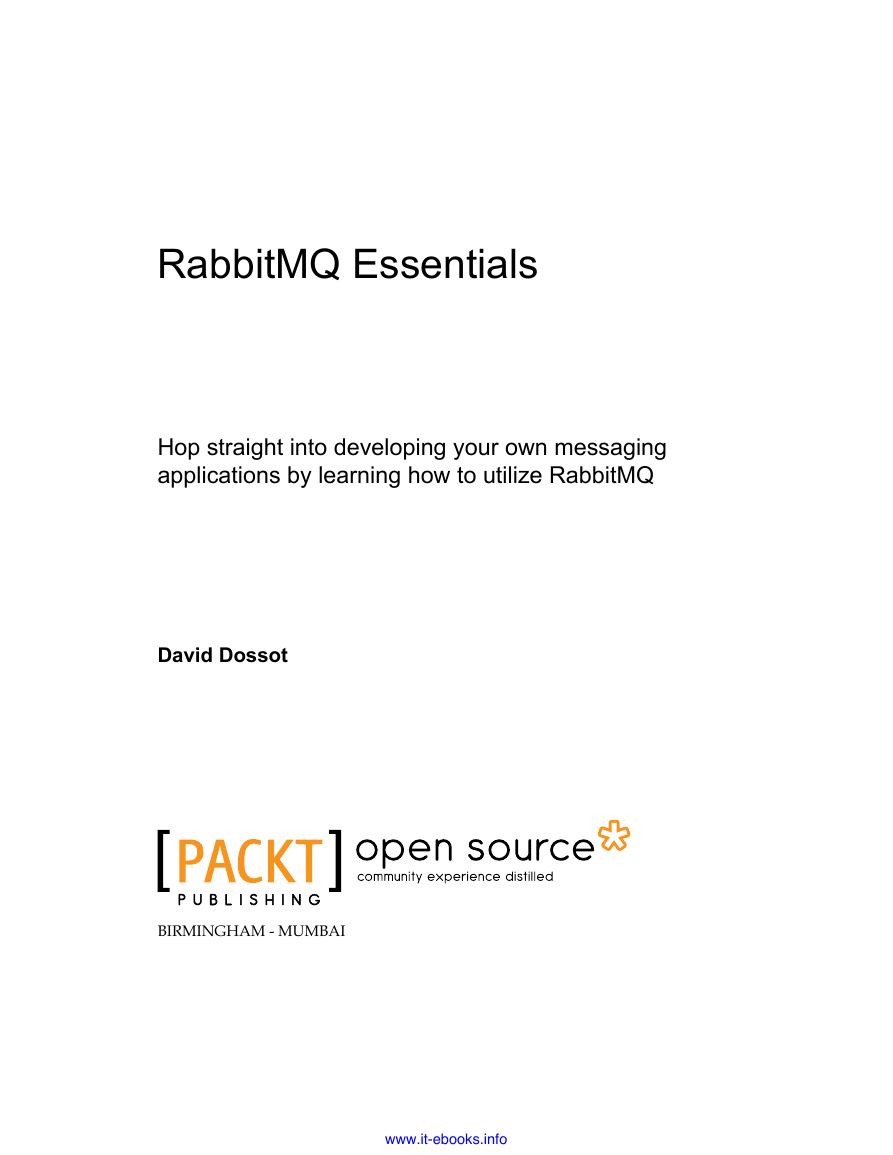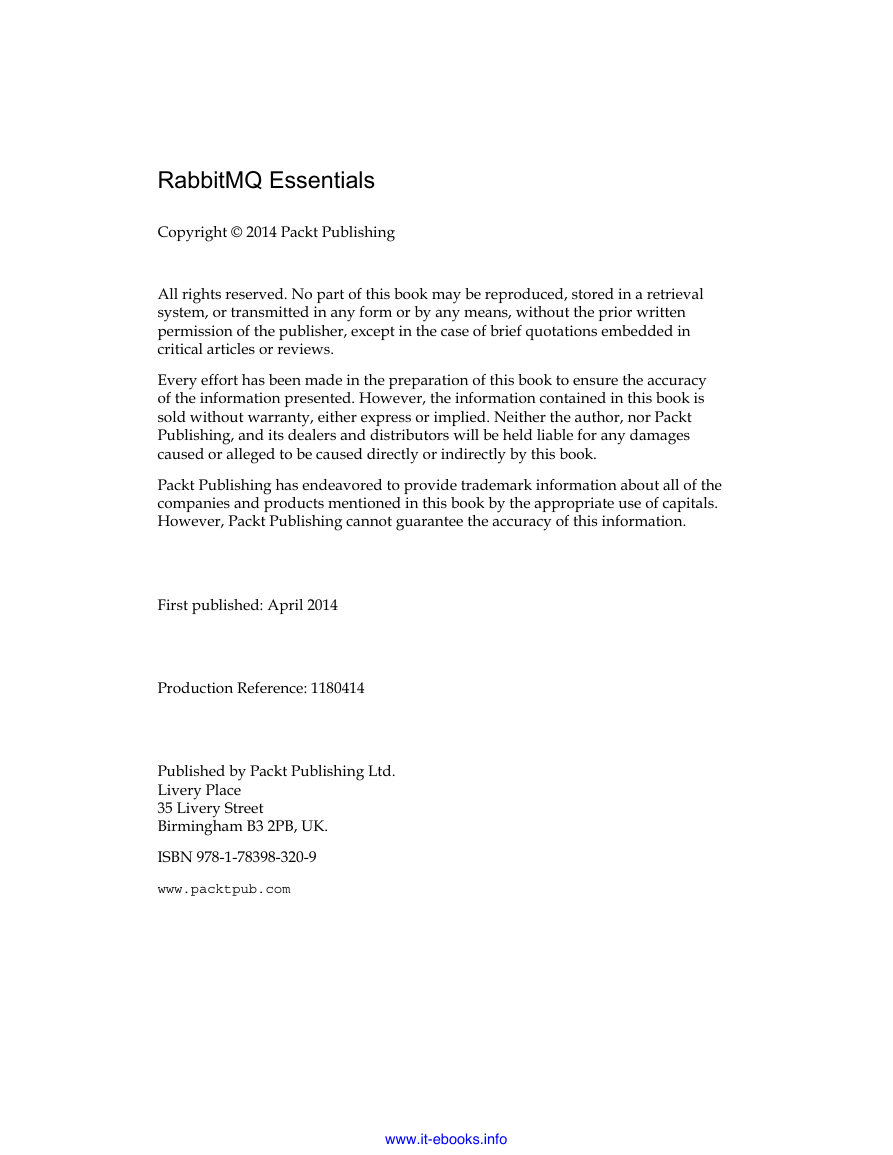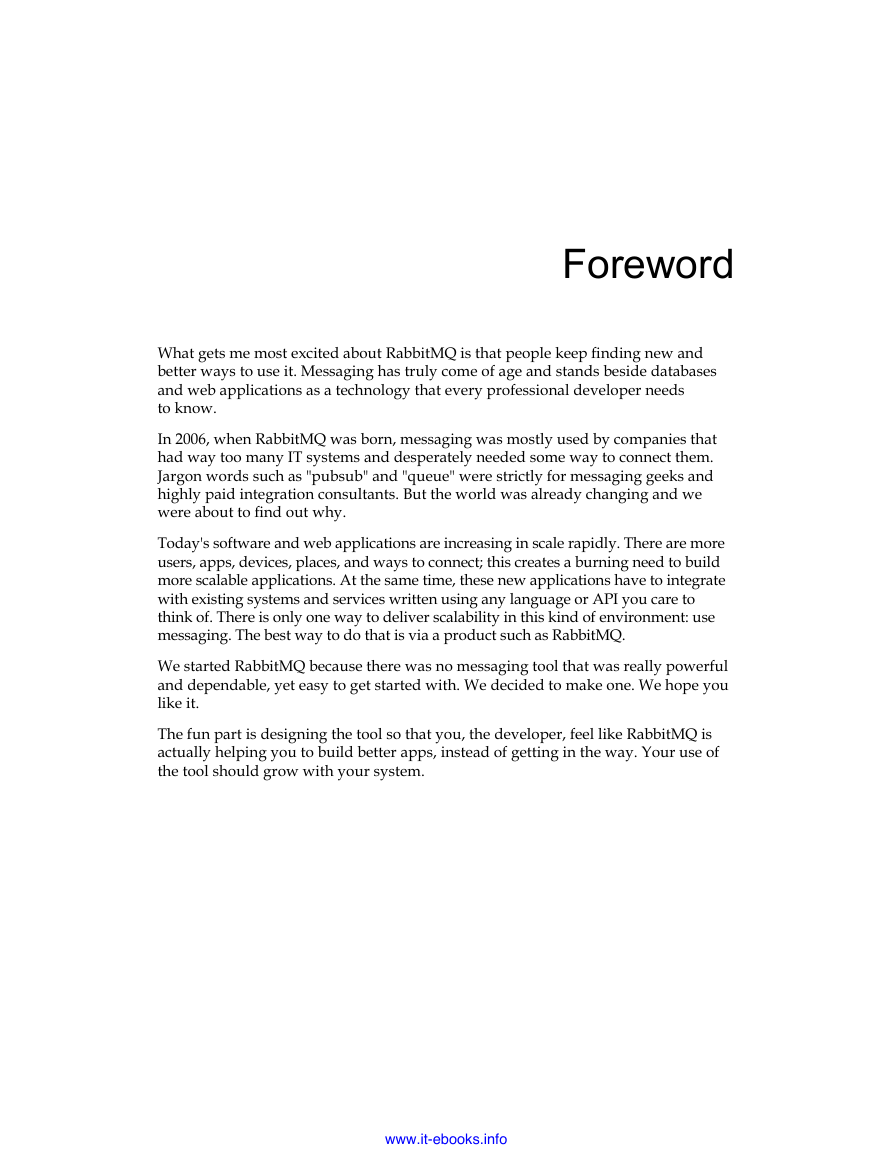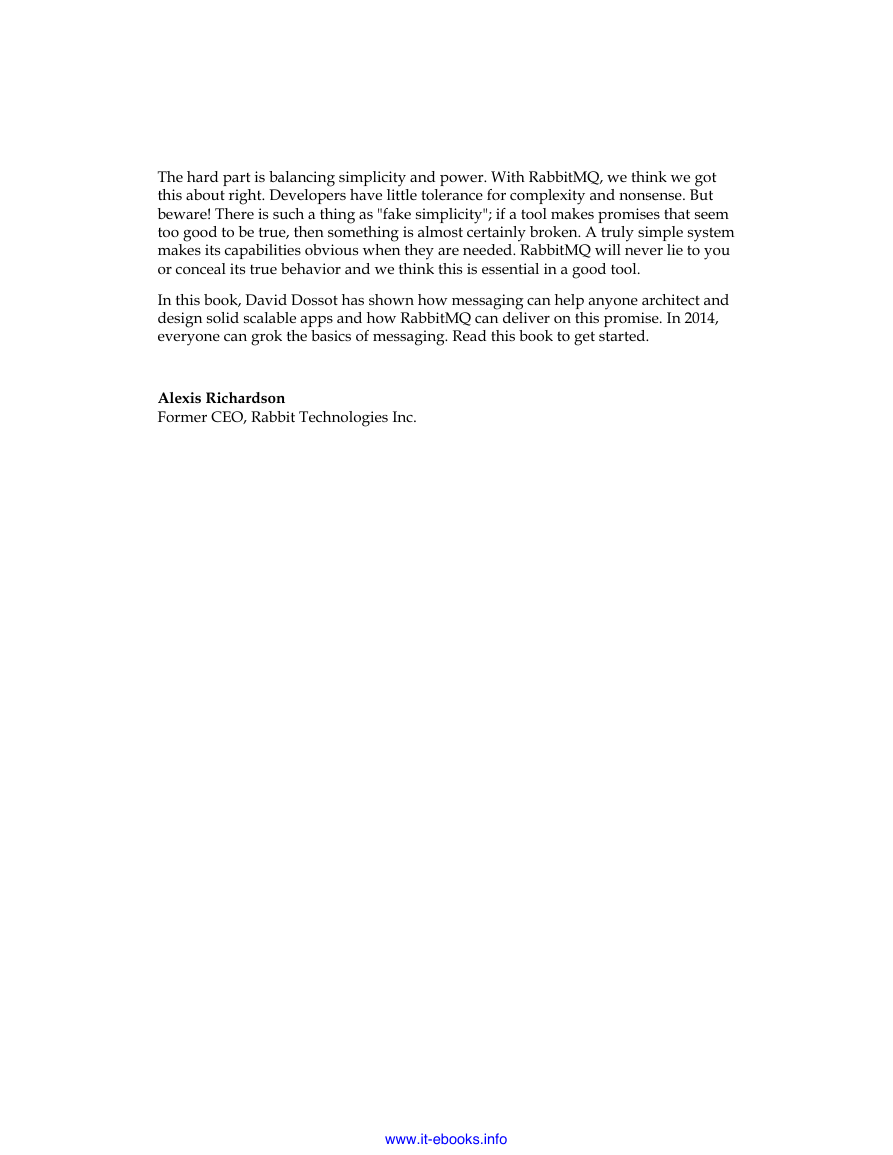www.it-ebooks.info
�
RabbitMQ Essentials
Hop straight into developing your own messaging
applications by learning how to utilize RabbitMQ
David Dossot
BIRMINGHAM - MUMBAI
RabbitMQ Essentials
Copyright © 2014 Packt Publishing
All rights reserved. No part of this book may be reproduced, stored in a retrieval
system, or transmitted in any form or by any means, without the prior written
permission of the publisher, except in the case of brief quotations embedded in
critical articles or reviews.
Every effort has been made in the preparation of this book to ensure the accuracy
of the information presented. However, the information contained in this book is
sold without warranty, either express or implied. Neither the author, nor Packt
Publishing, and its dealers and distributors will be held liable for any damages
caused or alleged to be caused directly or indirectly by this book.
Packt Publishing has endeavored to provide trademark information about all of the
companies and products mentioned in this book by the appropriate use of capitals.
However, Packt Publishing cannot guarantee the accuracy of this information.
First published: April 2014
Production Reference: 1180414
Published by Packt Publishing Ltd.
Livery Place
35 Livery Street
Birmingham B3 2PB, UK.
ISBN 978-1-78398-320-9
www.packtpub.com
www.it-ebooks.info
�
Credits
Project Coordinator
Puja Shukla
Proofreader
Ameesha Green
Indexer
Monica Ajmera Mehta
Graphics
Sheetal Aute
Ronak Dhruv
Abhinash Sahu
Production Coordinator
Alwin Roy
Cover Work
Alwin Roy
Cover Image
Sheetal Aute
Author
David Dossot
Reviewers
Ken Pratt
Ken Taylor
Ignacio Colomina Torregrosa
Héctor Veiga
Commissioning Editor
Ashwin Nair
Acquisition Editor
Richard Harvey
Content Development Editor
Govindan K
Technical Editors
Shruti Rawool
Nachiket Vartak
Copy Editors
Aditya Nair
Kirti Pai
www.it-ebooks.info
�
www.it-ebooks.info
�
Foreword
What gets me most excited about RabbitMQ is that people keep finding new and
better ways to use it. Messaging has truly come of age and stands beside databases
and web applications as a technology that every professional developer needs
to know.
In 2006, when RabbitMQ was born, messaging was mostly used by companies that
had way too many IT systems and desperately needed some way to connect them.
Jargon words such as "pubsub" and "queue" were strictly for messaging geeks and
highly paid integration consultants. But the world was already changing and we
were about to find out why.
Today's software and web applications are increasing in scale rapidly. There are more
users, apps, devices, places, and ways to connect; this creates a burning need to build
more scalable applications. At the same time, these new applications have to integrate
with existing systems and services written using any language or API you care to
think of. There is only one way to deliver scalability in this kind of environment: use
messaging. The best way to do that is via a product such as RabbitMQ.
We started RabbitMQ because there was no messaging tool that was really powerful
and dependable, yet easy to get started with. We decided to make one. We hope you
like it.
The fun part is designing the tool so that you, the developer, feel like RabbitMQ is
actually helping you to build better apps, instead of getting in the way. Your use of
the tool should grow with your system.
www.it-ebooks.info
�
The hard part is balancing simplicity and power. With RabbitMQ, we think we got
this about right. Developers have little tolerance for complexity and nonsense. But
beware! There is such a thing as "fake simplicity"; if a tool makes promises that seem
too good to be true, then something is almost certainly broken. A truly simple system
makes its capabilities obvious when they are needed. RabbitMQ will never lie to you
or conceal its true behavior and we think this is essential in a good tool.
In this book, David Dossot has shown how messaging can help anyone architect and
design solid scalable apps and how RabbitMQ can deliver on this promise. In 2014,
everyone can grok the basics of messaging. Read this book to get started.
Alexis Richardson
Former CEO, Rabbit Technologies Inc.
www.it-ebooks.info
�
About the Author
David Dossot has worked as a software engineer and an architect for more than
18 years. He has been using RabbitMQ since 2009 in a variety of different contexts.
He is the main contributor to the AMQP transport for Mule. His focus is on building
distributed and scalable server-side applications for the JVM and the Erlang VM.
He is a member of IEEE, the Computer Society, and AOPA, and holds a diploma in
Production Systems Engineering from ESSTIN.
He is a co-author for the first and second editions of Mule in Action (Manning
Publications Co.). He is a Mule champion and a DZone Most Valuable Blogger.
He commits on multiple open source projects and likes to help people on Stack
Overflow. He's also a judge for the annual Jolt Awards software competition.
I would like to thank my wife for giving the thumbs up to this
book project, while just recovering from the previous book. It was a
stretch goal, but with her support and the patience and love of the
rest of my family, it became possible. I'm also grateful to the rainy
winters we get in the Pacific Northwest as I didn't feel bad staying
inside writing!
I would like to extend a special thanks to our early reviewers—
without them, the book wouldn't be as great as it is now. I want to
use this opportunity to give kudos to a bunch of first class software
engineers and architects who have inspired me and from whom
I've learned so much throughout my career: Romuald van der
Raaij, André Weber, Philip Thomas, Pierre-Antoine Grégoire, Carl
Schmidt, Tim Meighen, Josh Devins, Dominic Farr, Erik Garrett, and
Ken Pratt.
www.it-ebooks.info
�
















 2023年江西萍乡中考道德与法治真题及答案.doc
2023年江西萍乡中考道德与法治真题及答案.doc 2012年重庆南川中考生物真题及答案.doc
2012年重庆南川中考生物真题及答案.doc 2013年江西师范大学地理学综合及文艺理论基础考研真题.doc
2013年江西师范大学地理学综合及文艺理论基础考研真题.doc 2020年四川甘孜小升初语文真题及答案I卷.doc
2020年四川甘孜小升初语文真题及答案I卷.doc 2020年注册岩土工程师专业基础考试真题及答案.doc
2020年注册岩土工程师专业基础考试真题及答案.doc 2023-2024学年福建省厦门市九年级上学期数学月考试题及答案.doc
2023-2024学年福建省厦门市九年级上学期数学月考试题及答案.doc 2021-2022学年辽宁省沈阳市大东区九年级上学期语文期末试题及答案.doc
2021-2022学年辽宁省沈阳市大东区九年级上学期语文期末试题及答案.doc 2022-2023学年北京东城区初三第一学期物理期末试卷及答案.doc
2022-2023学年北京东城区初三第一学期物理期末试卷及答案.doc 2018上半年江西教师资格初中地理学科知识与教学能力真题及答案.doc
2018上半年江西教师资格初中地理学科知识与教学能力真题及答案.doc 2012年河北国家公务员申论考试真题及答案-省级.doc
2012年河北国家公务员申论考试真题及答案-省级.doc 2020-2021学年江苏省扬州市江都区邵樊片九年级上学期数学第一次质量检测试题及答案.doc
2020-2021学年江苏省扬州市江都区邵樊片九年级上学期数学第一次质量检测试题及答案.doc 2022下半年黑龙江教师资格证中学综合素质真题及答案.doc
2022下半年黑龙江教师资格证中学综合素质真题及答案.doc